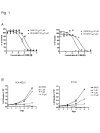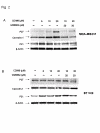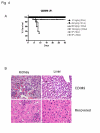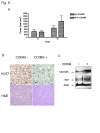1,1-Bis(3'-indolyl)-1-(p-biphenyl)methane inhibits basal-like breast cancer growth in athymic nude mice
- PMID: 17764562
- PMCID: PMC2206732
- DOI: 10.1186/bcr1761
1,1-Bis(3'-indolyl)-1-(p-biphenyl)methane inhibits basal-like breast cancer growth in athymic nude mice
Abstract
Introduction: 1,1-Bis (3'-indolyl)-1-(p-biphenyl) methane (CDIM9) has been identified as a new peroxisome proliferator-activated receptor (PPAR)-gamma agonist that exhibits both receptor dependent and independent antitumor activities. CDIM9 has not previously been studied with respect to its effects against basal-like breast cancer. Our goal in the present study was to investigate the anti-basal-like breast tumor activity of CDIM9 in vitro and in vivo.
Methods: The effects of CDIM9 on cell protein and DNA syntheses were determined in basal-like breast cancer MDA-MB231 and BT549 cells in vitro. Maximum tolerated dose and dose-limited toxicity were determined in BalB/c mice, and antitumor growth activities were assessed in MDA-MB231 basal-like breast tumor xenografts in athymic nude mice.
Results: CDIM9 exhibited selective cell cytotoxicity and anti-proliferation effects on basal-like breast cancer lines. In MDA-MB231 cell, CDIM9 induced caveolin-1 and p27 expression, which was significantly downregulated by co-treatment with the PPAR-gamma antagonist GW9662. Nonsteroidal anti-inflammatory drug-activated gene-1 and activating transcription factor-3 were upregulated by CDIM9 through a PPAR-gamma independent pathway. CDIM9 (40 mg/kg daily, intraperitoneally, for 35 days) inhibited the growth of subcutaneous MDA-MB231 tumor xenografts by 87%, and produced a corresponding decrease in proliferation index. Nearly half of the treated mice (46%) had complete durable remissions, confirmed by histology. The growth of an established tumor was inhibited by CDIM9 treatment (64 mg/kg daily, intraperitoneally, for 10 days), with a mean tumor growth inhibition of 67% as compared with controls. CDIM9 induced increases in tumor caveolin-1 and p27 in vivo, which may contribute to its antitumor activity in basal-like breast cancer.
Conclusion: CDIM9 showed potent antiproliferative effects on basal-like breast cancer cell in tissue culture and dramatic growth inhibition in animal models at safe doses. These findings justify further development of this drug for treatment of basal-like breast cancer.
Figures






Similar articles
-
1,1-Bis(3'-indolyl)-1-(p-substituted phenyl)methanes inhibit colon cancer cell and tumor growth through PPARgamma-dependent and PPARgamma-independent pathways.Mol Cancer Ther. 2006 May;5(5):1362-70. doi: 10.1158/1535-7163.MCT-06-0002. Mol Cancer Ther. 2006. PMID: 16731770
-
Inhibition of bladder tumor growth by 1,1-bis(3'-indolyl)-1-(p-substitutedphenyl)methanes: a new class of peroxisome proliferator-activated receptor gamma agonists.Cancer Res. 2006 Jan 1;66(1):412-8. doi: 10.1158/0008-5472.CAN-05-2755. Cancer Res. 2006. PMID: 16397256
-
1,1-Bis(3'-indolyl)-1-(p-substituted phenyl)methanes inhibit proliferation of estrogen receptor-negative breast cancer cells by activation of multiple pathways.Breast Cancer Res Treat. 2008 May;109(2):273-83. doi: 10.1007/s10549-007-9648-y. Epub 2007 Jul 12. Breast Cancer Res Treat. 2008. PMID: 17624585
-
In vivo antitumor activity of MEK and phosphatidylinositol 3-kinase inhibitors in basal-like breast cancer models.Clin Cancer Res. 2009 Jul 15;15(14):4649-64. doi: 10.1158/1078-0432.CCR-09-0317. Epub 2009 Jun 30. Clin Cancer Res. 2009. PMID: 19567590
-
Psychosocial stressors and mammary tumor growth: an animal model.Neurotoxicol Teratol. 2000 Jan-Feb;22(1):89-102. doi: 10.1016/s0892-0362(99)00049-5. Neurotoxicol Teratol. 2000. PMID: 10642118 Review.
Cited by
-
Comparative safety, pharmacokinetics, and off-target assessment of 1,1-bis(3'-indolyl)-1-(p-chlorophenyl) methane in mouse and dog: implications for therapeutic development.Toxicol Res (Camb). 2024 Apr 21;13(2):tfae059. doi: 10.1093/toxres/tfae059. eCollection 2024 Apr. Toxicol Res (Camb). 2024. PMID: 38655145 Free PMC article.
-
Evaluation of self-emulsified DIM-14 in dogs for oral bioavailability and in Nu/nu mice bearing stem cell lung tumor models for anticancer activity.J Control Release. 2015 Sep 10;213:18-26. doi: 10.1016/j.jconrel.2015.06.014. Epub 2015 Jun 14. J Control Release. 2015. PMID: 26079185 Free PMC article.
-
A novel bisindole-PBD conjugate causes DNA damage induced apoptosis via inhibition of DNA repair pathway.Cancer Biol Ther. 2014 Oct;15(10):1320-32. doi: 10.4161/cbt.29705. Epub 2014 Jul 10. Cancer Biol Ther. 2014. PMID: 25010292 Free PMC article.
-
A Role for the PPARgamma in Cancer Therapy.PPAR Res. 2008;2008:314974. doi: 10.1155/2008/314974. PPAR Res. 2008. PMID: 18528521 Free PMC article.
-
Stx2 Induces Differential Gene Expression and Disturbs Circadian Rhythm Genes in the Proximal Tubule.Toxins (Basel). 2022 Jan 19;14(2):69. doi: 10.3390/toxins14020069. Toxins (Basel). 2022. PMID: 35202097 Free PMC article.
References
-
- Smigal C, Jemal A, Ward E, Cokkinides V, Smith R, Howe HL, Thun M. Trends in breast cancer by race and ethnicity: update 2006. CA Cancer J Clin. 2006;56:168–183. - PubMed
Publication types
MeSH terms
Substances
LinkOut - more resources
Full Text Sources
Miscellaneous

